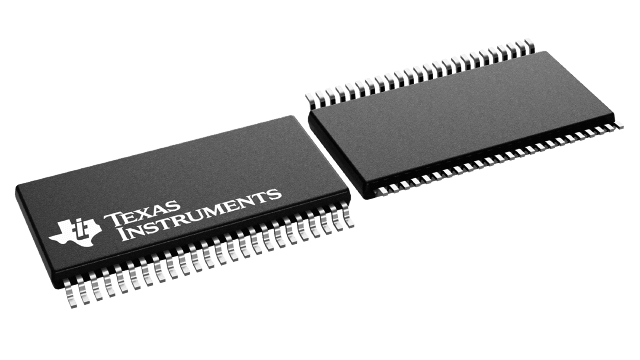Gehäuseinformationen
| Gehäuse | Pins TSSOP (DGG) | 48 |
| Betriebstemperaturbereich (°C) -40 to 85 |
| Gehäusemenge | Träger 2.000 | LARGE T&R |
Merkmale von SN74GTLP22033
- Member of the Texas Instruments Widebus™ Family
- TI-OPC™ Circuitry Limits Ringing on Unevenly Loaded Backplanes
- OEC™ Circuitry Improves Signal Integrity and Reduces Electromagnetic Interference
- Bidirectional Interface Between GTLP Signal Levels and LVTTL Logic Levels
- Split LVTTL Port Provides a Feedback Path for Control and Diagnostics Monitoring
- AO Outputs Have Equivalent 26-
 Series Resistors, So No External Resistors Are Required
Series Resistors, So No External Resistors Are Required - LVTTL Interfaces Are 5-V Tolerant
- High-Drive GTLP Open-Drain Outputs (100 mA)
- Reduced LVTTL Outputs (-12 mA/12 mA)
- Variable Edge-Rate Control (ERC) Input Selects GTLP Rise and Fall Times for Optimal Data-Transfer Rate and Signal Integrity in Distributed Loads
- Ioff, Power-Up 3-State, and BIAS VCC Support Live Insertion
- Distributed VCC and GND Pins Minimize High-Speed Switching Noise
- Latch-Up Performance Exceeds 100 mA Per JESD 78, Class II
- ESD Protection Exceeds JESD 22
- 2000-V Human-Body Model (A114-A)
- 200-V Machine Model (A115-A)
- 1000-V Charged-Device Model (C101)
OEC, TI-OPC, and Widebus are trademarks of Texas Instruments.
Beschreibung von SN74GTLP22033
The SN74GTLP22033 is a high-drive, 8-bit, three-wire registered transceiver that provides inverted
LVTTL-to-GTLP and GTLP-to-LVTTL signal-level translation. The device allows for transparent, latched, and
flip-flop modes of data transfer with separate LVTTL input and LVTTL output pins, which provides a feedback
path for control and diagnostics monitoring, the same functionality as the SN74FB2033. The device provides
a high-speed interface between cards operating at LVTTL logic levels and a backplane operating at GTLP signal
levels. High-speed (about three times faster than standard LVTTL or TTL) backplane operation is a direct result
of GTLP's reduced output swing (<1 V), reduced input threshold levels, improved differential input, OEC™
circuitry, and TI-OPC™ circuitry. Improved GTLP OEC and TI-OPC circuits minimize bus-settling time and have
been designed and tested using several backplane models. The high drive allows incident-wave switching in
heavily loaded backplanes with equivalent load impedance down to 11  .
.
The AO outputs, which are designed to sink up to 12 mA, include equivalent 26- resistors to reduce overshoot
and undershoot.
resistors to reduce overshoot
and undershoot.
GTLP is the Texas Instruments derivative of the Gunning Transceiver Logic (GTL) JEDEC standard JESD 8-3. The ac specification of the SN74GTLP22033 is given only at the preferred higher noise margin GTLP, but the user has the flexibility of using this device at either GTL (VTT = 1.2 V and VREF = 0.8 V) or GTLP (VTT = 1.5 V and VREF = 1 V) signal levels. For information on using GTLP devices in FB+/BTL applications, refer to TI application reports, Texas Instruments GTLP Frequently Asked Questions, literature number SCEA019, and GTLP in BTL Applications, literature number SCEA017.
Normally, the B port operates at GTLP signal levels. The A-port and control inputs operate at LVTTL logic levels, but are 5-V tolerant and can be directly driven by TTL or 5-V CMOS devices. VREF is the B-port differential input reference voltage.
This device is fully specified for live-insertion applications using Ioff, power-up 3-state, and BIAS VCC. The Ioff circuitry disables the outputs, preventing damaging current backflow through the device when it is powered down. The power-up 3-state circuitry places the outputs in the high-impedance state during power up and power down, which prevents driver conflict. The BIAS VCC circuitry precharges and preconditions the B-port input/output connections, preventing disturbance of active data on the backplane during card insertion or removal, and permits true live-insertion capability.
This GTLP device features TI-OPC circuitry, which actively limits overshoot caused by improperly terminated backplanes, unevenly distributed cards, or empty slots during low-to-high signal transitions. This improves signal integrity, which allows adequate noise margin to be maintained at higher frequencies.
High-drive GTLP backplane interface devices feature adjustable edge-rate control (ERC). Changing the ERC input voltage between low and high adjusts the B-port output rise and fall times.This allows the designer to optimize system data-transfer rate and signal integrity to the backplane load.
When VCC is between 0 and 1.5 V, the device is in the high-impedance state during power up or power down. However, to ensure the high-impedance state above 1.5 V, OEAB\ should be tied to VCC through a pullup resistor and OEAB and OEBA should be tied to GND through a pulldown resistor; the minimum value of the resistor is determined by the current-sinking/current-sourcing capability of the driver.
